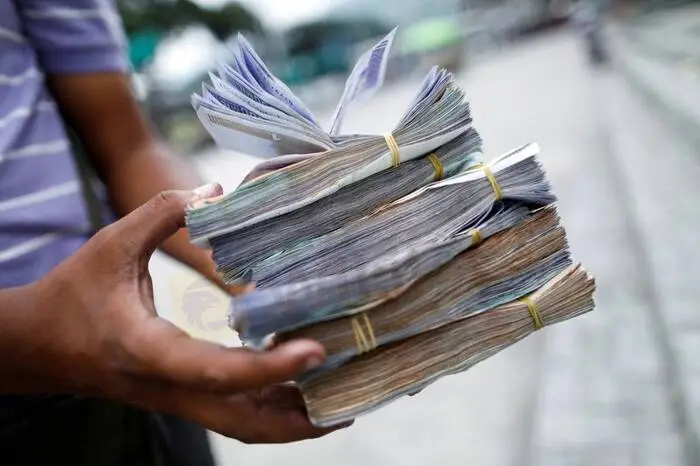简体中文
繁體中文
English
Pусский
日本語
ภาษาไทย
Tiếng Việt
Bahasa Indonesia
Español
हिन्दी
Filippiiniläinen
Français
Deutsch
Português
Türkçe
한국어
العربية
Venezuelas public companies quadruple foreign currency sales to central bank
Abstract:Sales of foreign currency by Venezuela‘s public companies, including oil producer PDVSA, to the South American country’s central bank quadrupled in 2021, according to a document seen by Reuters.

Sales of foreign currency by Venezuela‘s public companies, including oil producer PDVSA, to the South American country’s central bank quadrupled in 2021, according to a document seen by Reuters.
Advisors to President Nicolas Maduro‘s administration spoke to investors and bondholders from Europe and the United States about their country’s economic potential during a call organized by the Spanish Chamber of Commerce in Venezuela on Wednesday, two sources familiar with the matter said.
Included in data discussed on the call were economic indicators and information showing that the flow of foreign currency to Venezuelas central bank hit $3.39 billion in 2021, up from $743 million the year before, the document showed.
Some of the foreign currency was used to maintain stability in the exchange rate between the bolivar and the dollar, as well as to cover government expenses.
The rise in foreign currency sales to the monetary authority follows an uptick in PDVSA‘s oil production and exports, despite U.S. sanctions. Venezuela’s oil output hit 871,000 barrels per day in November, the same document said.
Venezuela suspended payments to bondholders in 2017 when it proposed debt negotiations. However, that plan was put on ice by the countrys unfolding crisis, while sanctions prevented U.S. citizens and companies from dealing with Venezuelan officials.
Venezuela tried a similar renegotiation in 2020 without success.
Neither Venezuelas ministry of communication nor the Spanish Chamber of Commerce responded to requests for comment.
Advisors to Vice President Delcy Rodriguez reminded bondholders during the call of economic policy changes and raised the possibility of injecting capital into sectors such as oil, mining, tourism and agriculture. They also highlighted that Venezuelas third-quarter economic growth hit 7.6% last year, the sources said.
The country has struggled amid a long-running recession and high prices. In 2019 the government loosened financial regulations to aid businesses, which helped but are not enough to provide a full recovery, analysts say.

Disclaimer:
The views in this article only represent the author's personal views, and do not constitute investment advice on this platform. This platform does not guarantee the accuracy, completeness and timeliness of the information in the article, and will not be liable for any loss caused by the use of or reliance on the information in the article.
Read more

Blockchain Decentralization: Empowering a Trustless Future
In recent years, blockchain technology has rapidly evolved from a niche innovation behind Bitcoin into a transformative force across industries. At its core, blockchain decentralization refers to the distribution of authority and decision-making away from a central entity and into the hands of a distributed network of participants. This shift redefines how data is stored and verified and paves the way for trustless, transparent, and resilient systems that challenge traditional centralized models.

The president of @Liberland, @Vít Jedlička come on stage, dialogue on trading security.
The 2025 WikiEXPO Hong Kong Station is about to grandly open. the president of @Liberland, @Vít Jedlička come on stage, dialogue on trading security.

Countdown: 1 day.WikiEXPO2025's first stop, Hong Kong, is about to open.
⏰ Countdown: 1 day. WikiEXPO2025's first stop, Hong Kong, is just tomorrow. Focus on transaction security and explore new investment opportunities. ???? Get ready to start now. See you tomorrow.
JustMarkets Review 2025: Live & Demo Accounts, Withdrawal to Explore
Established in 2012, JustMarkets (Formerly JustForex) is an online forex broker based in Cyprus and serves clients in over 160 countries. Featuring a low entry barrier, a 50% deposit bonus, and robust trading platforms -MT4 and MT5, JustMarkets has gained great popularity among retail investors in recent years. JustMarkets allows traders to trade over 260 CFD-based instruments, which is not an extensive range, yet on leverage up to 3000:1 to increase trading flexibility. To enhance the trading experience, both MT4 and MT5 are provided, along with JustMarkets Trading App, MetaTrader Mobile App, and MetaTrader WebTerminal. JustMarkets offers a 50% deposit bonus to boost traders' confidence. Opening an account is a fully online process, typically completed within one day.
WikiFX Broker
Latest News
Exposing the Top 5 Scam Brokers of March 2025: A Closer Look by WikiFX
Gold Prices Climb Again – Have Investors Seized the Opportunity?
Webull Launches SMSF Investment Platform with Zero Fees
Australian Regulator Warns of Money Laundering and Fraud Risks in Crypto ATMs
The Withdrawal Trap: How Scam Brokers Lure Victims into Paying More
FCA to Investors: Think Twice Before Trusting These Brokers
Trump\s tariffs: How could they affect the UK and your money
Trump gambles it all on global tariffs he\s wanted for decades
HTFX Spreads Joy During Eid Charity Event in Jakarta
How Will the Market React at a Crucial Turning Point?
Currency Calculator







